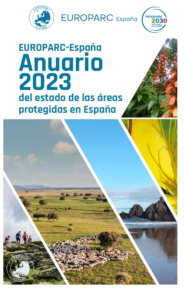Management effectiveness evaluation shows: Finnish park management is of high standard but challenges lie ahead
Photo description: Evaluation Team visiting fortress island Vallisaari. Long closed for military use, the site has remained one of the most diverse nature destinations in the archipelago of capital city Helsinki. From the left: Ben Ross, Nigel Dudley, Sue Stolton (team leader), Michael Hošek, Kari Lahti, Petri Ahlroth, Yu-Fai Leung. Team members absent: Ari-Pekka Auvinen and Naira Dehmel.
Photo: Mervi Heinonen, Metsähallitus Parks & Wildlife Finland
Expert article from Matti Tapaninen, Senior Specialist, Tourism. Metsähallitus Parks & Wildlife Finland.
Conservation agencies around the world need plenty of timely, transparent and quality information to be able to manage their national parks and nature reserves efficiently. In addition to the baseline information of ecological, cultural, social and economic values of Protected Areas, there is growing interest to monitor trends and predict changes in the future. Needs to measure and enhance management effectiveness are also recognized in the Kunming-Montreal Global Biodiversity Framework, which states:
Ensure and enable that by 2030 at least 30 per cent of terrestrial and inland water areas, and of marine and coastal areas, especially areas of particular importance for biodiversity and ecosystem functions and services, are effectively conserved and managed.
EU and national biodiversity strategies play a crucial role in achieving this goal.
Protected Area Management Effectiveness
Protected area management effectiveness (PAME) assessment is a useful tool to organize great amounts of information and it helps to get fresh insights from external evaluators. In 2004, Finland was the first country in the world to commission an independent review of the management effectiveness of the whole protected area system. In 2023, Metsähallitus Parks & Wildlife Finland (PWF) repeated the process. The Evaluation Team itself consisted of experts representing a range of expertise, including managing a park agency, biodiversity research units, conservation-related private consultancies, and visitor and tourism management.
The 2023 PAME Assessment
The 2023 PAME assessment was guided by the Principles of Protected Area Management in Finland, which encompass key components of management objectives, ecosystem services and ecosystem approach, and adaptive management process that are operating under a changing environment along with national and regional obligations. The evaluation protocol entailed a system-wide questionnaire with six broad categories of questions, including context, planning, input/resources, process, outputs, and outcomes.
Special attention was paid to important changes in the management context since 2004, as well as future domestic and regional trends that may facilitate, hinder or otherwise impact management effectiveness in one or more categories. The focus of evaluation was on the protected area system in Finland, but additional evidence was obtained from site assessments using the Management Effectiveness Tracking Tool (METT) in five Protected Areas.
According to the PAME assessment report management of Protected Areas in Finland is of a high standard and the protected area system managed by Parks & Wildlife Finland works well. However, significant challenges lie ahead. Many species are endangered, threats due to climate change are increasing and resources available for management are declining. Henrik Jansson, Executive Director of Parks & Wildlife Finland, says:
The international assessment is an important step towards safeguarding biodiversity and more effective conservation work. This assessment provides guidelines for increasing the impact of the work and helps to compare our competence internationally. Next, we will analyse the recommendations and draw up a development plan from them. We will prioritise the recommendations that we can implement promptly.
A comment by Michael Hošek, President of EUROPARC Federation and member of the international evaluation team
Globally, Finland was the first country to develop a methodology to evaluate the effectiveness of its Protected Areas system in 2004. Moreover, Finnish colleagues understood the importance of an independent perspective, i.e. they invited international experts to the evaluation team.
In 2023, after 20 years, the evaluation was carried out again. The methodology was updated, of course, but with the awareness that the results could be compared to see trends in development.
Personally, I consider the combination of the assessment at the level of the Protected Areas network and the specific sites of great importance. We cannot assume that we have the capacity to carry out a very thorough and repeated evaluation of effectiveness at the level of each individual site. The Finnish example is innovative in this respect, as it combines the assessment at the level of the network and a sample of sites while maintaining the quality of the result. And to make the evaluation truly independent, it is really important to invite colleagues from other countries to the team, taking into account the experience of other countries within Europe and the world. And I hope we have done that. I am personally very happy with the result.
More information
Full evaluation reportThe full evaluation report Management Effectiveness Evaluation of Finland’s Protected Areas 2023 (pdf)
Report summary and recommendationsThe report summary and its recommendations (pdf): Management Effectiveness Evaluation of Finland’s Protected Areas 2023 – Summary of the Evaluation Report and Recommendations.
System level evaluationSystem-level evaluation of protected area management effectiveness for Parks & Wildlife Finland (PAME) – complete assessment questionnaire with evaluation criteria (pdf)
Evaluating Effectiveness (IUCN)Evaluating Effectiveness: A framework for assessing management effectiveness of protected areas. 2nd Edition. (IUCN publication, pdf)
MPA4Change at the Ocean Decade Conference 2024, Barcelona.
From April 5th to 12th 2024, the UNESCO Ocean Decade Conference 2024 was hosted in Barcelona as part of the UN Decade of Ocean Science for Sustainable Development (2021- 2030).
Coordinated by UNESCO’s Intergovernmental Oceanographic Commission (IOC/UNESCO), the Ocean Decade seeks to stimulate ocean science and transform this knowledge into action to reverse the decline of the ocean ecosystem and catalyse new opportunities for sustainable development.
This international event provided a convening framework for a wide range of stakeholders across the world to generate data, information and knowledge needed that will contribute to a well- functioning, productive, resilient, sustainable and inspiring ocean.
The Ocean Decade MPA Forum, a satellite event.
Due to the vast number of initiatives that requested a slot in the Conference, which reflects how relevant marine conservation currently is, the Ocean Decade Conference counted with a vast array of satellite events organised in its framework.
Among them, the Ocean Decade MPA Forum – Marine Protected Areas: Progress, Obstacles and Solutions was independently organised by several international organisations – among which the EUROPARC Federation, and provided an opportunity to exchange on the current status of Protected Areas worldwide. Counting with a strong representation from both Latin America and the Mediterranean region, the Forum allowed participants to explore four key themes that are driving the contribution of MPAs to the Ocean Decade goals: Challenges, Best Practices, Solutions, Maintaining Momentum and Scaling Up.
A clear message came out from the presentations: biodiversity conservation goes beyond legal protection; to really achieve it, an effective management of the MPA is urgently needed. However, the sad reality is that the vast majority of MPAs worldwide still lack management plans.
Management plans should be built on two pillars: science and early participation of relevant stakeholders. People need to be part of the process, not just be informed at the very end. The implementation of management plans should entail monitoring and surveillance. Technology brings new opportunities to achieving this. Several presentations focused on the use of electronic and aero-maritime (drones, or remote control mini-boats) monitoring systems for surveillance of both coastal and large remote MPAs.

Joaquim Garrabou speaking, Ocean Decade MPA Forum – Photo by EUROPARC Federation.
International cooperation is also key to achieve biodiversity conservation. When we look at the movement of water particles, we realise how connected everything is; there is permanent movement from one site to another. Likewise, MPAs from a same region, share the same migrant species and face the same issues – the spread of non-indigenous species, pollutants, and heat waves. Cooperation allows for early alert of emergencies, fast track solutions and accelerate legislation changes. It also allows for a stronger voice.
In this sense, a recent alliance created between Colombia, Costa Rica, Panama and Ecuador to boost the Eastern Tropical Pacific Marine Conservation Corridor – CMAR was presented. Equally, the MedPAN network and MedFund, a new environmental trust fund based in Monaco, specifically dedicated to the financing of marine protected areas in the Mediterranean, were introduced.
Climate Change Adaptation and Restoration in Marine Protected areas
Among the initiatives presented for “Keeping the momentum and Scaling Up”, both Joaquim Garrabou from the Marine Science Institute of Barcelona (ICM), as part of the Spanish Research Council (CSIC), and Teresa Pastor from the EUROPARC Federation, had the opportunity to introduce the work underway in order to foster the adaptation of Marine Protected Areas to Climate Change in the Mediterranean region and the rest of Europe.
Joaquim Garrabou focused on explaining the current situation and threats that Marine Protected Areas are facing in the Mediterranean and how climate change effects are equally jeopardizing the marine ecosystem services which the Mediterranean area strongly relies on, as well as the ability of Marine Protected Areas itself to protect the habitats and species they shelter.
100 MPAs adapted to climate change by 2030
Joaquim also highlighted that we are strongly behind schedule to achieve the conservation goals set by the Convention on Biological Diversity and the Biodiversity Strategy, and that we urgently need to improve the effectiveness of MPAs at all levels. In order to move forward and deliver time-bound and specific results, he set as a target to support 100 MPAs to set climate change adaptation strategies in place by 2030 the Mediterranean region.
By 2030, we expect that 100 MPAs in the Mediterranean basin will count with climate change adaptation strategies in place – Joaquim Garrabou, CSIC.
This target will be reached through the implementation of MPA4Change project, which offers a set of toolkits developed in previous Interreg Euro-Med initiatives, addressing different factors underpinning the effectiveness of MPAs in achieving their conservation goals.
The solutions offered by MPA4Change

Teresa Pastor in the panel discussion, Ocean Decade MPA Forum – Photo by EUROPARC Federation.
Furthermore, a more in detail revision of the solutions that MPA4Change project bring to the table was presented by Teresa Pastor, Policy and Project Manager – Sustainable Tourism Manager from the EUROPARC Federation. These solutions focus on areas such as participation, climate change vulnerability assessment and monitoring, citizen science activities, adaptation strategies and communication. They form the key components that experienced MPAs will transfer to other areas willing to improve their capacities to increase their resilience to Climate Change. Additionally, and also as a result of MPA4Change, a group of experts will be created to support MPAs in the process of adaptation to climate change.
In her presentation, Teresa also explained how these toolkits will be integrated, in the form of recommendations, into regional and European policies in order to set alliances with relevant institutions such as SPA/RAC, and regional networks such as MedPan and the Union for the Mediterranean, which were strongly represented during the Forum. Finally, Teresa called to MPA representatives present among the participants to join MPA4Change and incorporate the solutions offered to adapt to climate change.
A Call to all European Parks and Trails | World Trails Conference
Our executive director Carol Ritchie will speak at the #WorldTrailsConference in Ottawa!
Taking place from September 30 to October 3, 2024, the Conference will bring together trail leaders, experts and fellow enthusiasts.
With a long history of ancient pilgrimages, herding routes, long-distance hikes and transnational Grande routes criss-crossing the continent, the European experience of managing trails is somewhat unique. As an important means of managing multi-use visitors and of seeking to mitigate wildlife disturbance whilst enabling people to get into nature, trails are the most obvious and fundamental part of any park’s infrastructure.
Trails too are a way of attracting and serving tourists visiting our parks and are often an economic driver of an area. Great trails often come through our parks and they connect to areas outwith our Protected Areas.
Understanding their importance in the landscape is vital in linking people to place but too as a valuable line of communication to interpret the culture, wildlife and indeed climate change impacts around us.
EUROPARC is recommending all European parks and trail managers to consider attending the World Trails Congress in Ottawa, Canada from September 30 to October 3 2024, to bring this wealth of European experience to the world stage but also to find new approaches and management practices from across the world.
Hosted by the Trans Canada Trail, the 2024 World Trails Conference will focus on connection – to people, places and the planet. Explore the profound bonds that link humanity to the natural world and develop a new understanding of how our trails impact the environment, communities and each other.
EUROPARC will be represented at the congress, but are seeking to encourage a large European delegation to join, to discuss the benefits and challenges trails bring to our Protected Areas.
Early bird fees close soon… so make sure to register online at: worldtrailsconference.org
Do you have interesting case studies or news to share with us on this topic? Then please do reach out to us! We want to amplify the work happening in Europe!
Submit your case studyState of play of Protected Areas in Spain
The commitment to Protected Areas in Spain is strong, with more than 36% of the land surface area protected and, shortly, 21% of the marine surface area.
Yearbook 2023 on the state of Protected Areas in Spain
The Yearbook of Protected Areas in Spain 2023, – published by EUROPARC Spain on the 18th of March 2024 and available in Spanish language – showcases the state of the art of Protected Areas in this country and includes an analysis of several aspects of concern.
Spain has 36.7% of the protected land area and 12.3% of the marine area, a figure that will soon rise to 21%. It stands out as the country with higher contribution of Protected Areas to the European Natura 2000 network, and the one with the highest number of biosphere reserves in the world, with 53 designated territories. These figures provide a solid basis for tackling many of the commitments related to the European Union’s Biodiversity Strategy.
Partnerships for conservation and socio-economic revitalisation
Protected Areas are essential tools within environmental, social and economic policies. Furthermore, in an increasingly urbanised society, they provide access to nature and to its enjoyment – Spanish National Parks alone receive almost 14 million visitors.
Protected Areas are also areas of opportunity for green activity and employment, especially in rural areas.
says Juana Barber, President of EUROPARC Spain.
Additionally, initiatives such as the European Charter for Sustainable Tourism in Protected Areas (ECST) – promoted by the EUROPARC Federation – are an example scheme that allows quality recognition for products and services from Protected Areas. The ECST has involved 30 protected natural areas in Spain, 526 tourism companies and 10 travel agencies that voluntarily participate in the initiative.
Active management, experiences and field practices
Protected Areas play an essential role not solely in the conservation and restoration of ecosystems and their biodiversity. There is growing evidence and experiences of the role that Protected Areas play in tackling the challenges of climate change, articulating the necessary cooperation between sectoral policies and stressing the socio-economic benefits of nature conservation.

Among other experiences, the Yearbook of Protected Areas in Spain 2023 portrays examples on the contribution of Protected Areas to the different future challenges we, as a society, face. Such is the case of an European project for adaptation to climate change in a Natural Park in Galicia and an initiative for climate change mitigation in the Natural Parks of the Chartered Community of Valencia. Likewise, we can find examples like the commitment to conservation and revitalisation of rural areas in a recently created Natural Park in La Rioja and the experience of a decade of collaborative work to promote sustainable tourism in La Gomera island, driven by Garajonay National Park.
The report is available online at EUROPARC Spain website in Spanish language – take a closer look to this significant report by clicking the button below.
To the Yearbook 2023 page